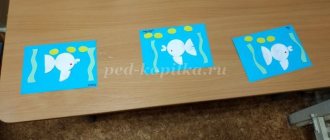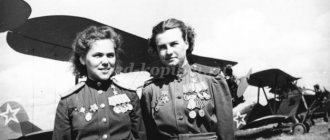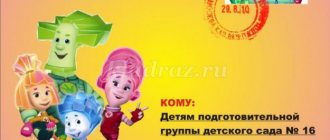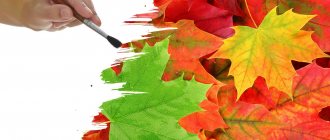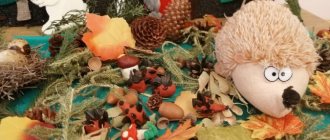Junior group project “Victory Day”
Thank you to everyone who gave their lives, For our native Rus', for freedom, Who forgot fear and fought, Serving our beloved people. Thank you, your feat is eternal, As long as my country lives, you are in our souls, in our hearts, we will never forget the heroes, never!
Type of project: social - creative Duration: short-term (1 week). Project goal: Formation of children's knowledge about the Great Patriotic War through various types of activities. Project objectives: - To foster moral and patriotic feelings in children through broadening their general horizons. — To form basic knowledge about the events of the Great Patriotic War on the basis of vivid ideas accessible to children and to evoke emotional experiences in them. — To develop respect for the defenders of the Motherland, pride for the Russian people, love for the Motherland. — To promote the development of joint activities of the child and his parents in the process of becoming familiar with the history of the Great Patriotic War..
Project implementation plan: 1. Conversation “May holiday - Victory Day.” 2. Consideration of material on the topic “Victory Day”, postcards “Cities of Heroes”, illustrations and albums “The Great Patriotic War”. 3. Reading and memorizing poems on the theme “Victory Day”: A. Zharov “Zvezdochka”, T. Belozerova “Victory Day”, N. Ivanova “What a holiday”, M. Poznanskaya “Victory”, M. Gettuev “In the radiant they have given endless blooms.” 4. Reading and discussion of stories about the Great Patriotic War: L. Kassil “Monument to the Soviet Soldier”, E. Blaginin “The Overcoat”, S. Mikhalkov “Serving the Soviet Union”, O. Vysotskaya “Glory to the Soviet Army”, V. Orlov “Parade” ", A. Mityaev "Why is the army dear to everyone." 5. Learning and reading proverbs and sayings about peace and family with children. 6. Listening to and learning songs about the war: “Victory Day”, “Our Motherland is Strong” by A. Filippenko 7. NOD for cognitive development “Victory Day - celebrated by the whole country.” 8. Didactic games: “Military equipment” (cut-out pictures), “Who will I serve in the Army”, “Find and bring”, “Identical objects”. 9. Outdoor games: “Go through the swamp”, “Snipers”, “Pilots to the airfield”, “Find and bring”, “Knock down the pin”. 10. Plot-role-playing games: “Sailors”, “Hospital”. 11. Physical education, “Pilots”, “Soldier”, “Brave Soldier”. 12. Finger games: “Family”, “Our Army”, “These fingers are all fighters”. 13. NOD for artistic and aesthetic development “Fireworks in honor of Victory Day.” Presentation of the project: Entertainment “Victory Day is a glorious holiday!”
Applications to the “Victory Day” project. Conversation "May holiday - Victory Day." Objectives: - To give children knowledge about the Victory Day holiday, about how the Russian people defended their country during the Great Patriotic War, how the living remember them. — Activate the emotional sphere of children and thereby make them want to participate in the conversation. — Enrichment of vocabulary. — Cultivate respect and love for people who defend their homeland from enemies, war veterans, and take care of them. Progress of the conversation: Educator: May 9 is the most important holiday celebrated in our country. What holiday is it? Victory Day is the greatest and most important holiday, both for Russia and for many other countries of the world. It was very difficult not only for Russian soldiers and officers, but also for all residents of our Motherland, adults and children, during the war. The army, with the help of the people, defeated the enemies and drove them out of Russia, and then from other countries. On Victory Day, people lay wreaths and flowers at military monuments
Now listen to the poem: “Remember forever!” (excerpt) Wherever you go or go, But stop here, Bow down to this grave with all your heart. Whoever you are - Fisherman, miner, Scientist or shepherd - remember forever: here lies your best friend. Both for you and for me He did everything he could: He did not spare himself in battle and saved his homeland. Author: M. Isakovsky Educator: It was a terrible and long war. On an early June morning, Sunday June 22, 1941, the predawn silence was suddenly broken by explosions of roaring shells. Thus began the war. At that time, no one knew that it would go down in human history as the bloodiest. No one guessed that the Soviet people would have to go through inhuman tests, pass and win. To rid the world of fascism, showing everyone that the spirit of a Red Army soldier cannot be broken by the invaders. The entire people rose to defend the Motherland, our army, women, old people, and even children. Our brave soldiers did not allow the Nazis to approach Moscow, but themselves went on the offensive. This war was difficult, difficult and terrible; many people died in it. But the long-awaited Victory Day has arrived. Our valiant soldiers drove out the Nazis and themselves came to Berlin and hoisted a flag over the Reichstag (this is the main building in Berlin). This happened on May 9, 1945. And since then, every resident of our country, and residents of other countries, celebrate this holiday. "Victory Day".
The May holiday - Victory Day, is celebrated by the whole country. Our grandfathers put on the Military Orders. In the morning the road calls them to the solemn parade. And thoughtfully from the threshold, the grandmothers look after them. T. Belozerov Educator: In this war, as I already said, not only adults, but also children took part. Writers and poets wrote many poems and stories about their exploits. Our people fought bravely and won. But not everyone lived to see the Great Victory. So that no one forgets the valiant heroes and their exploits, many monuments were built throughout the country in memory of war heroes, mass graves in which soldiers killed in battle were buried (show illustration).
There are few participants in the war left: many years have passed since the Victory Day. Our government takes care of its heroes and helps them. You, too, must treat the war veterans and all older people with respect and gratitude. They defended our Motherland and preserved peace on Earth. And we have one Motherland. Poem reading:
"Motherland". If they say the word Motherland, the old house immediately comes to mind, currants in the garden, a thick poplar at the gate. By the river there is a modest birch tree, and a daisy hillock. And others probably remember their native Moscow courtyard. The first boats are in the puddles, Where recently there was a skating rink. And from the large neighboring factory, a loud, joyful whistle. Or the steppe red with poppies, the golden virgin lands... The homeland can be different, but everyone has the same one! (Zinaida Alexandrova) Take care of your Motherland, grow up honest, courageous, brave. Reading and discussion of poems used in the project. "Our star." In the flames of battles for native power, a star lit up on an army helmet. And on the cap at that very moment, its light appeared in the expanse of the sea. The shadows swayed, the darkness trembled, The star shone, the star grew, Bravely crushing the fierce misfortune, We carried the red star around the world... In the civil war and in the big war, the star shone with the sun on a par with the sun, In it is the glory of the fatherland, in it is the honor of the people And mine, comrade, there is a drop of blood. With her we defeated the evil enemy, The power of our truth is dear to the world! We defended our happiness with her. (A. Zharov) “Victory Day”. May holiday - Victory Day. The whole country celebrates. Our grandfathers put on the Military Orders. In the morning the road calls them to the solemn parade. And thoughtfully from the threshold, the grandmothers look after them. (T. Belozerova)
“What kind of holiday?” There are festive fireworks in the sky, fireworks here and there. The whole country congratulates the Glorious Veterans. And the blooming spring Gives them tulips, Gives them white lilacs. What a glorious day in May? (N. Ivanova) “Victory” Front-line songs, Military awards, Red tulips, Meetings of veterans. And fireworks in half the sky, Huge as Victory. Victory Day has come to us, the best holiday on earth. It’s a lot of fun today, for both kids and kids! M. Poznanskaya “In radiant bloom, boundless distances” In radiant bloom, boundless distances, And songs ring across the vastness of the country. Both the sun and the song were defended in battle by the Heroes of a long-defunct war. M. Gettuev Proverbs and sayings used in working on the project. • Clouds cannot cover the sun, peace cannot be won by war. • Light will conquer darkness, and peace will conquer war.
• The world stands before the army, and the army stands before the world. • Peace to the people - life will be more beautiful year after year. • Peace and work go hand in hand. • Where there is peace, there is joy. • Stand together for peace - there will be no war. • Peace builds, but war destroys. • He is our enemy who does not value peace. • He who sows peace will reap happiness. • A bad peace is better than a good quarrel. • Peace is not expected, it is won. • Peace is not expected, peoples take it into their own hands. • To live in the world is worldly and to create. NOD for cognitive development “Victory Day – celebrated by the whole country.” Goal: To cultivate a sense of respect for Veterans of the Great Patriotic War, the desire to please them. Develop a sense of composition, color and rhythm. Material: letter, Military Equipment toys, a selection of pictures about Victory Day, illustrations depicting battles of the Great Patriotic War, pictures or postcards with images of tulips. Preliminary work: Examination of illustrations “Military equipment”, “Defenders of the Fatherland”.
GCD progress: Educator: Guys, what spring holidays do you know? Children: March 8, Easter, Victory Day. Educator: And what holiday are they talking about “With tears in their eyes?” (Answers.) Educator: That’s right, “Victory Day,” but why is this holiday called that? (Answers.) - Which of you can read a poem about Victory Day? Children: The May holiday - Victory Day, is celebrated by the whole country. Our grandfathers put on military orders. In the morning the road calls them to the solemn parade. And thoughtfully from the threshold, the grandmothers look after them. Educator: Guys, what is a holiday? That's right, it's fun, laughter, joy, happiness. We always celebrate the holidays with great joy. Today I want to tell you about the holiday that is celebrated on May 9 - Victory Day. Every year our country celebrates a great holiday - Victory Day in the Great Patriotic War. The Great Patriotic War began on June 22, 1941. The enemy attacked a peaceful country at night, when all the people were sleeping, without declaring war on us. The enemies hoped for an easy and quick victory. They wanted to seize the rich lands of our country. But they were wrong. All people, young and old, stood up to defend their free, beloved Motherland. Not only men, but also women fought in the war. They were nurses, doctors, orderlies. Children also took an active part; in hospitals they helped the soldiers eat, write letters home, sang songs to them, read poems, raising their spirits. On May 9, 1945, the war ended, and that day became the brightest and most beloved holiday, Victory Day! Guys, today the postman brought us an envelope. Now we'll see what's in the envelope. I take the invitation out of the envelope. Educator: This is an invitation. I wonder where? Let's read it. “Dear guys, we invite you to an exhibition of military equipment, where you will get acquainted with military vehicles that helped soldiers defeat enemies during the war and are now protecting our Motherland. You will remember who controls these machines.” Let's go to the exhibition of military equipment.
Educator: So we came to the exhibition of military equipment. See what cars you know? (plane, ship, tank, helicopter) Educator: Guys, who flies the plane? (pilot) - Who drives the tanks? (tanker) - Who serves on the ship? (sailor) - Guys, did you like the car exhibition? - What kind of cars are these? (military). - Do you want to be soldiers? Fine. Now we will march in formation like soldiers. Physical education All the guys know, Marsh. A brave soldier, A brave soldier cannot be broken. All the guys know the Brave Soldier, bending his arms at the elbows - “strongmen.” They will never be able to win. Educator: That's how we had a good rest. Guys, do you think sailors alone could have won the war? Pilots? Tankers? Why? Educator: They couldn’t do it right. “Tankers on tanks are eager to fight. Pilots are firing from the sky. There is a struggle at sea and on land. We all really need a victory." — Guys, what do you think, is war good or bad? Why? (children's answers) - Guys, I agree with you, war is bad, let there always be peace on earth. Would you like to listen to a poem about peace? "We need peace" We need peace, On the blue planet. Both adults and children want it. They want, when they wake up at dawn, not to remember, not to think about the war! We need peace to build cities, plant trees and work in the fields. All people of good will want it. We need peace, Forever! Forever! (I. Kravchenko) Educator: Guys, May 9 - every year our country celebrates Victory Day in the Great Patriotic War. On this day, veterans gather, put on their orders and medals received for the heroic fight against the enemy, and go to the Victory Parade. (Show pictures of the parade.) They are given flowers, congratulations and songs are heard, and in the evening festive fireworks bloom over the cities of our country in honor of the victory. The Eternal Flame burns in every city. The eternal flame always burns, never goes out and reminds people of the terrible word “war”, that this should never happen again. Adults and children need peace on the entire planet. Guys, let's also thank our veterans who live in our city for the victory. And we will make cards for them with spring flowers - tulips. Everyone who sees our postcards will understand that you and I remember the feat of Russian soldiers, and are grateful to them for the victory, for the peaceful sky above our heads. Why make tulips, because these flowers always bloom for this holiday. Children gluing tulips together with the teacher. (Victory Day music plays). Educator: Well done! You made some wonderful cards.
Summary of the lesson. What did we talk about in class today? (About Victory Day.) When is Victory Day celebrated? (May 9.) Where do children and adults lay flowers on May 9? (To the Eternal Flame.) What did we do today? (Postcards.) Who did we make postcards for? (For veterans.) And at the end of our lesson, I want to read you the poem “Victory Day.” Victory Day May 9 is a holiday of peace in the country and spring. On this day we remember the soldiers who did not return to their families from the war. On this holiday we honor the grandfathers who defended their native country, who gave the peoples Victory, and who returned peace and spring to us! (N. Tomilina) Description of didactic games used in the work on the project. "Military equipment". Goal: To form children’s ideas about military transport. Develop fine motor skills and instill pride in our Army. Learn to correlate the image of a representation with a holistic image of a real object, to fold a picture cut into 4 parts. Equipment: Cut-out pictures of military equipment from 4 parts. Military equipment corresponding to the images in the pictures. Progress of the game. On the table in front of the children are cut-out pictures depicting military equipment. Children participating in the game are asked to put together a picture from parts so that they get a whole object. The child who first collects the cut picture wins.
“Who will I serve in the Army?” Objectives: To develop children’s knowledge about military professions. Develop imagination, cultivate pride in our Fatherland. Progress of the game. Children are presented with pictures or photographs depicting weapons, equipment, objects and attributes used by the military. Based on the choice the child made, the military profession should be determined. Name what troops the child wants to serve in when he grows up. “Find and bring.” Goal: Development of visual memory, auditory attention, auditory memory. Consolidating the concept of shape, size and color of objects. Equipment: All types of multi-colored playing materials familiar to children from previous games are used: flags, circles, ribbons, pyramids, etc. You can also take any objects available in the group and painted in different colors. Progress of the game. The teacher lays out subject pictures in prominent places, then calls the child, gives him one of the paired pictures (the child must name what is drawn) and asks him to find the same picture using it. In this game, as in other didactic games, various, more complex options are possible: 1) the teacher only shows a paired picture, and the child looks for the same one from memory; 2) instead of pictures, the teacher places objects in visible places, the child must find the corresponding object from the picture. “Identical objects” Purpose: To teach children to find identical objects of different colors. Develop speech, attention, and the ability to compare objects. Develop fine motor skills of fingers. Equipment: 24 cards with objects of primary colors. How to play: An adult lays out cards in front of the child and asks him to find identical objects. For example, an adult takes a card with a green car and asks the child to find another similar car in a different color. In order for him to understand the rules of the game, it is necessary to show him how to play this game by pointing to a red car and explaining that the cards show cars of different colors. Description of outdoor games used in the work on the project. “Go through the swamp” Goal: get over the “swamp” (hoops). Bring shells (cones), which are stored on the other side of the “swamp”. Rules of the game: you cannot step on the red hoops - these are peat hummocks that can burst into flames at any moment. A child who steps on a red hoop is considered wounded. “Snipers” Goal: hit an enemy truck carrying ammunition with a bag. Rules of the game: you can’t cross the line, otherwise you can “explode” along with the truck. The team with the most hits wins. “Pilots to the airfield” Objectives: to teach how to navigate in space using various types of simulated movements. Learn to follow the established rules of the game and improve communication skills. Rules of the game: On the command “Pilots to the airfield”, everyone runs out and sits on all fours. At the command “Start the engines”, we perform the “motor” movement. On the command “Planes have taken off”, they fly around the hall. At the command “Pilots to land,” they land. “Crawl - don’t touch” Goal: To teach children to crawl in different ways (leaning on their knees and palms, on their feet and palms), and also to teach them to climb over an obstacle, crawl without touching an obstacle. Improve skills in crawling over a limited area, straight and inclined, in climbing vertical stairs, develop coordination of movements, dexterity, and cultivate courage. Rules of the game: Children are located on one side of the room. At a distance of 3-4 m from them, chairs are placed, on the seats of which gymnastic sticks or long slats are placed. Two or three children must crawl under the sticks, trying not to touch them, crawl to the bench on which the flags lie, stand up, take the flags and wave them, then run back. Directions: You can increase the crawling distance. “Knock down the pin” Goal: To improve children’s skills in handling various objects (balls, balls, hoops). Continue to develop the ability to roll balls and throw them in a certain direction with both hands and one hand. Learn to hit the target, develop your eye, coordination, and dexterity. Rules of the game: A line is drawn on the ground. At a distance of 1-1.5 m from it, 2-3 large pins are placed (the distance between the pins is 15-20 cm). Children take turns approaching this place, picking up the lying balls, rolling them, trying to knock down the pin. After rolling 3 balls, the child runs, collects them and passes them to the next player. Instructions: balls with a diameter of 15-20 cm. Description of the plot-role-playing games used in the work on the project. “Sailors” Goal: To develop the ability to perform several game actions combined into a plot with the help of an adult. Learn to act independently in improvisation. Foster friendly relationships and a sense of teamwork. Vocabulary work: anchor, captain, ship, helm, helmsman, sailor. Preliminary work: reading fiction about ships, sailors, viewing photographs about the sea, sailors, ships. Equipment: naval collar, captain's cap, medical gown, anchor, steering wheel, binoculars, building material. Progress of the game: - Guys, I propose to go on a trip together today. What can you go on a trip with? (By plane, by train, by car, by ship) - To travel on a ship, what do you need to do? (Build a ship) - What will we cost the ship from? (From a large builder and Lego) Children, together with the teacher, build the side of the ship, place a steering wheel on the deck, install a gangway, an anchor, and seats for passengers. - The ship is ready. Who's on the ship? Who needs what for work? (The teacher takes on the role of captain and helps distribute the roles of who will be who. Then you can invite one of the children to be captain). Children: For the captain - binoculars, for the sailors - caps, for the doctor - a suitcase with tools, medicine, for the cook - dishes and food. - What is the captain doing? Determines the course of the ship and gives commands. Right hand drive, left hand drive! Full speed ahead! The helmsman is at the helm. The sailors are scrubbing the deck. The radio operator reports the movement of the ship. A doctor monitors the health of the crew on the ship. The cook prepares food for the whole team. The music “Sound of the Sea” plays. The captain gives the command: “Everyone get ready to sail, undergo a medical examination.” The doctor examines the entire team. After being cleared for navigation, the team boards the ship. The captain gives the command: “Passengers take their seats!” They take up space on the ship. The captain gives the command: “Raise anchor! Raise the ladder! Full speed ahead! " The captain constantly gives commands to the helmsman: “Full speed ahead!” Turn to the left! The captain asks the cook to prepare lunch for the crew. The sailors saw that there was land ahead. The captain leads to the pier, the Navigator is at the helm (Children put their palm to their forehead, peer into the distance). Everyone returns home, the passengers, the doctor, the sailors leave the ship first, the captain is the last to leave. "Hospital". Goals: continue to introduce children to the professions of doctor and nurse; arouse interest in the professions of medical workers; develop children's speech and enrich their vocabulary; help children establish interactions in joint play; cultivate a sensitive and attentive attitude towards the patient, kindness, responsiveness, and a culture of communication. Equipment: medical cards according to the number of children, a toy phonendoscope, a spatula, a thermometer, brilliant green, a table, 2 white coats for a doctor and a nurse, 2 white caps, cotton wool, a bandage, a syringe. Game progress: Doctor: The hospital opens. I am a doctor. Who came to my appointment? Patient: (complaining). I am doctor. Doctor: Sit down, patient. Tell me exactly where your pain is concentrated? Patient: I have a cough and a sore throat. Doctor: Let me listen to you. Breathe deeply. (Listen to the patient with a tube.) You are coughing a lot. Show me your throat. Now we need to measure the temperature. Take a thermometer. High temperature. You need to take medicine. This. (gives a bottle.) Pour into a spoon and drink every day. Did you understand? Patient: Yes. I will take the medicine as you ordered. Thank you Doctor. Goodbye. Description of physical education lessons used in working on the project. "Salute" Everything was quiet around. Stand up straight, lower your hands, And suddenly - fireworks! Firework! Raise your arms up. Rockets flashed in the sky both here and there! Open your fingers like a fan and wave your arms above your head. Above the square, above the roofs, Sit down, stand up, with open arms. Raise your fingers up over festive Moscow (2-3 times). The living fountain soars higher and higher. Out into the street, out into the street Easy running in place. Everyone runs joyfully, shouting: “Hurray! ", Raise your hands up, shout "Hurray. Enjoy the festive fireworks! Open your fingers like a fan, wave your arms above your head left and right. "Pilots". The hands were made to fly apart - it turned out to be an airplane. Hands to the sides. Wave your wing back and forth, wave your hand. Do it once and do it twice. Keep your arms at your sides. Hands to the side. And look at your friend. Get down quickly and sit down. Sit down to board. “Soldier” Stand on one leg, stand on one leg, hands on your belt. It's like you're a steadfast soldier. Well, get up boldly, and make sure you don’t fall. Now stand on the left, If you are a brave soldier. Now stand on your right, straighten your left leg, arms to the sides. If you are a good soldier. "Perdue". All the guys know, Marsh. A brave soldier, A brave soldier cannot be broken. All the guys know the Brave Soldier, bending his arms at the elbows - “strongmen.” They will never be able to win. Description of finger games used in the work on the project. "Family". Children are asked to bend the fingers of their left hand into a fist, then, while listening to the nursery rhyme, straighten them one by one, starting with the thumb. This finger is grandpa, This finger is grandma, This finger is daddy, This finger is mommy, This finger is me, That’s my whole family. “Our Army” Alternately “walk” with the index and middle fingers of the right and left hands. Aty-baty, aty-baty! Soldiers are coming to the parade! Here come the tankmen, Then the artillerymen, And then the infantry - Company after company! “These fingers are all fighters” These fingers are all fighters Daring fellows (spread your fingers, then clench them into a fist) Two large and strong small ones And soldiers experienced in battles. (raise 2 thumbs, press the others) Two guardsmen are brave (raise 2 index fingers) Two smart fellows (raise 2 middle fingers) Two nameless heroes But very nice at work (raise 2 ring fingers) Two little fingers are short Very nice boys. (raise 2 little fingers)
NOD for artistic and aesthetic development “Fireworks in honor of Victory Day”. Goal: To cultivate a sense of pride, love and respect for the homeland, the army, to give the concept of the expression “Victory Day”, to develop colloquial speech. Develop children's creative abilities through familiarization with unconventional drawing techniques. Deepen your understanding of color (yellow, red, green, blue). Materials: landscape sheet with pencil outlines of small circles, gouache in four colors, cotton swabs, pictures or postcards with images of fireworks (on the board) Preliminary work: examination of illustrations, photographs. Progress of NOD: Educator: Dear guys, you were born and live in a wonderful, peaceful time and do not know what war is. But very soon we will celebrate the great holiday “VICTORY DAY”. Do you know what kind of holiday this is? (Children’s answers) Reading the poem “What is Victory Day?” What is Victory Day? This is the morning parade: Tanks and missiles are driving, a line of soldiers is marching. What is Victory Day? This is a festive fireworks display: Fireworks fly into the sky, scattering here and there. What is Victory Day? These are songs at the table, These are speeches and conversations, This is grandfather's album. These are fruits and sweets, These are the smells of spring, What is Victory Day? This means no war. (Andrey Usachev) World War II is the largest war in human history; it began on June 22, 1941 with an unexpected attack by Germany. And it lasted for four long years. More than 20 million of our people died in this terrible war. Each of them had relatives and friends. The memory of the fallen heroes will forever remain in our hearts. There are monuments to famous and unknown heroes all over the country. People come to these monuments not only on holidays, but also on any day you can see flowers there. There is such a monument in our city (show illustration). Every year on May 9, a rally and a meeting of veterans takes place near it. Residents of the city come there to once again say kind words to the veterans who gave us a calm and joyful life. And once again he will bow low to all the dead who did not spare their lives in the struggle for a peaceful sky. There is a custom to honor the memory of fallen heroes with a minute of silence. Let us also now honor the memory of all those who died in the war with a minute of silence. (Everyone stands up.) Sit down, guys! Our soldiers performed many feats. There is no braver and more honest soldier in the world than a Russian soldier. Unfortunately, there are fewer and fewer of those who were direct participants in that war and to whom we owe our freedom. – Years, decades, centuries will pass, but we will never forget the bright, joyful Victory Day. Every year on May 9, fireworks are lit in honor of the Great Victory. The evening sky is colored with bright holiday lights. Reading the poem "Festive Fireworks" . Scarlet bouquets bloom in the sky, petals sparkle with sparkles of light. Asters flash blue, red, blue, purple - each time new. And then they flow like a golden river. What it is? Festive fireworks! The teacher shows images of festive fireworks.
Educator: (conversation with children) - What is shown in these illustrations? (children's answers). — What do fireworks look like? (children's answers). — What time of day is shown in the illustrations? (children's answers). — What colors are used to depict the fireworks? (children's answers). — What background is the fireworks shown on? (children's answers). — Why did the artist choose a dark background? (children's answers). — How could the artist feel while depicting fireworks? (children's answers). — Which illustration of fireworks did you like best? Why? (children's answers). Thanks for your answers, now let's stretch our fingers. Finger gymnastics: “Our Army” Alternately “walk” with the index and middle fingers of the right and left hands. Aty-baty, aty-baty! Soldiers are coming to the parade! Here come the tankmen, Then the artillerymen, And then the infantry - Company after company! Educator: We rested a little and prepared our fingers for drawing. Today we will draw festive fireworks, but we will draw in an unusual way, with cotton swabs. Look, in front of you lies a landscape sheet with pencil outlines of small circles. In these circles you will draw with cotton swabs, using the poke method, fireworks with different colors. Showing and explaining how to draw fireworks with cotton swabs. Educator: Guys, look at your drawings, what bright, festive fireworks you have created, well done!
When you come home today, do not forget to congratulate all your family and friends on the upcoming holiday. Ask your parents to take you to a festive concert dedicated to Victory Day. Take the flowers and take them to the monument to the unknown soldier
Consultation for parents “How to tell children about war.” Victory Day is the most important holiday celebrated in our country. On this day, all people congratulate veterans and lay wreaths and flowers at military monuments. It is important for children to know about the Victory Day holiday, about how the Russian people defended their country during the Great Patriotic War. To cultivate respect and love for people who defend the Motherland from enemies, war veterans, and take care of them. Here are some tips on how to tell children about the war: - talk about it with your child; - watch thematic programs on TV with your children (old war films that carry kindness, light, faith in Victory), a military parade, concerts of military songs; - read books, they will help give an idea of wartime. (Some books about war are written specifically for preschool age. They are simply beautiful, wise, they contain descriptions of spiritual kindness, perseverance and heroism); - learn poems, proverbs, sayings, songs about war; — talk to veterans. (Older people find contact with children more easily than parents. And they will definitely choose the right words when telling the child about their experience); — tell us about your ancestors who fought; — visit memorial places, congratulate veterans.

